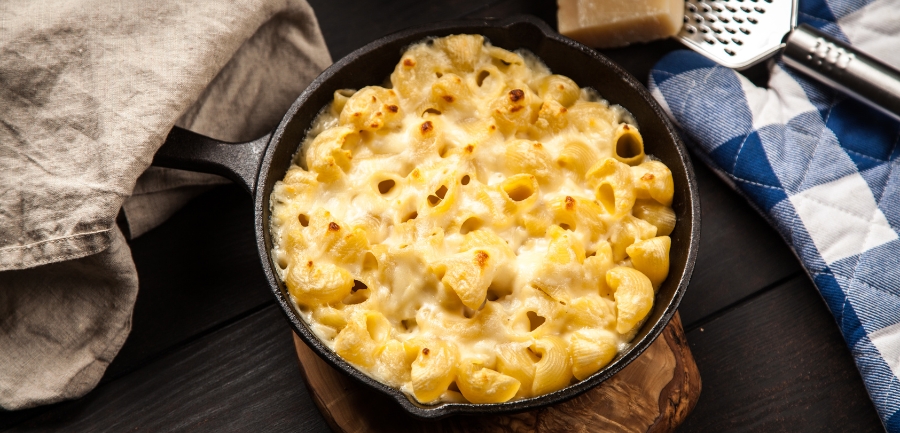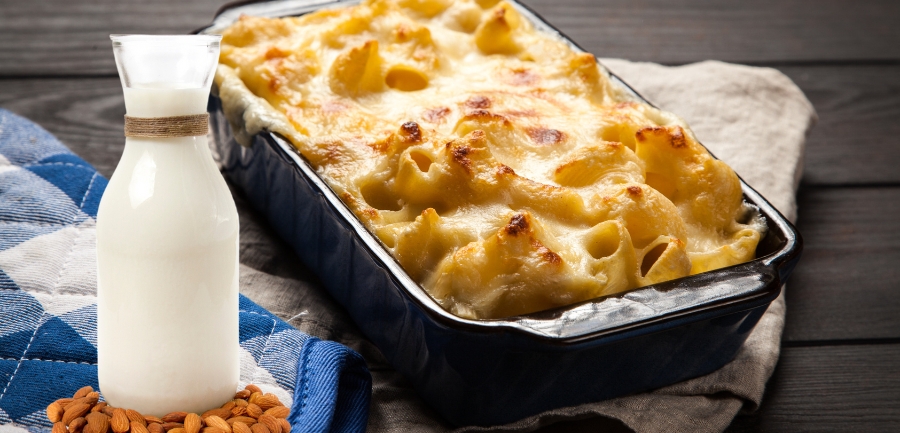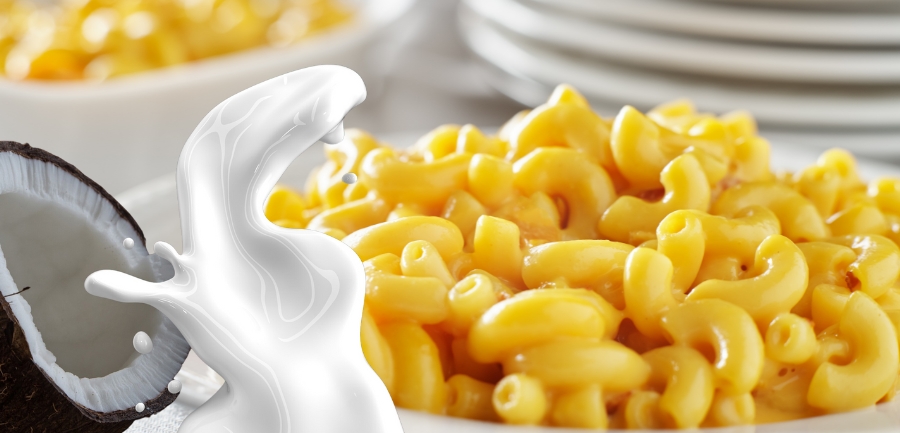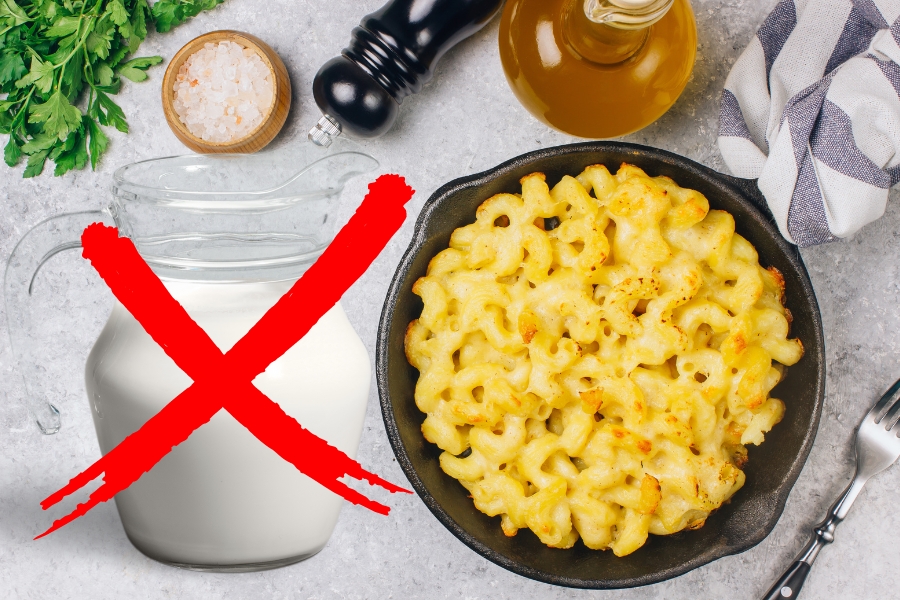Have you ever found yourself craving the warm, comforting dish of mac and cheese, only to realize you have no milk in your refrigerator? You might think your delicious plans have been dashed, but I’m here to reassure you – they haven’t!
Table of Contents
In the world of culinary creativity, there’s always room for improvisation and innovation. The absence of a particular ingredient like milk should not deter you from creating a mouthwatering masterpiece. In fact, it opens a world of opportunities to experiment with a diverse range of replacements, some of which might even prove tastier than the original.
This article aims to help you traverse the wide, wonderful landscape of milk substitutes for mac and cheese, guaranteeing that delightful creaminess and rich, cheesy flavor we all crave. Whether you’re lactose intolerant, vegan, or merely out of milk, let’s dive deep into the reservoir of creamy, dairy-free alternatives for your next mac and cheese feast.
Milk Substitute in Mac and Cheese

When the question arises, “What can I substitute for milk in mac and cheese?” the answer may surprise you. There’s a rich array of substitutes available, each offering a unique flavor profile and nutritional benefit.
One of the most straightforward substitutes for milk in mac and cheese is water. Although it might not impart the same creamy texture, it can be made up for by using a larger quantity of cheese. Alternatively, chicken or vegetable broth can be used to boost the flavor quotient.
If you’re seeking a more nutritious alternative, unsweetened almond milk can be an excellent choice. It offers a creamy texture similar to regular milk, without the lactose. This dairy-free alternative is a great way to keep the creaminess of your mac and cheese intact.
For vegans or those with a dairy allergy, there’s a world of plant-based substitutes to explore. Coconut milk is a popular choice, providing a slight sweetness and a luxurious, velvety texture. Soy milk also stands as a versatile option, with its neutral flavor allowing the cheese to shine through.
In a pinch, even Greek yogurt or sour cream diluted with a bit of water can act as a substitute for milk. These add richness and a tangy flavor that gives the mac and cheese an exciting twist.
Experimenting with milk substitutes in your mac and cheese can lead to incredible, flavorful discoveries. It’s all about finding what works best for your tastes and dietary needs.
Oat Milk in Mac and Cheese

If you’re looking for a dairy-free, vegan-friendly alternative that packs a punch of creaminess and flavor, then oat milk in mac and cheese should be your go-to substitute.
Oat milk is wonderfully creamy, naturally sweet, and somewhat nutty when produced by blending oats with water and then filtering the mixture. Given that it has a consistency that closely resembles that of cow’s milk, it is a great choice for mac and cheese because the dish will maintain its traditional, creamy texture.
Oat milk is a better option for individuals wishing to add some nutritional value to their comfort food because it also has a good quantity of protein and fiber. As it is free of lactose, nuts, and frequently gluten (check the box if you have a severe gluten allergy), it also works well for persons with allergies or intolerances.
Oat milk gives mac and cheese a subtle sweetness that goes perfectly with the salty cheese when you use it. Although it pairs well with a variety of cheeses, old cheddar or pungent vegan cheese is ideal.
All in all, using oat milk in your mac and cheese can take your comfort food to a whole new level of deliciousness and healthiness.
Can You Use Almond Milk in Mac and Cheese?

Absolutely, you can use almond milk in mac and cheese, and it can provide a delicious twist to your traditional recipe. Almond milk, with its slightly sweet and nutty undertones, adds a unique flavor profile that can elevate your dish to new gastronomic heights.
The unsweetened version of almond milk is the finest choice when using it. This makes sure that the dish’s savory, cheesy richness doesn’t get drowned out by the almonds’ sweetness. Almond milk is a healthier option for people limiting their calorie consumption because it has less fat and calories than cow’s milk.
One of the significant benefits of using almond milk in your mac and cheese is its creamy consistency. It maintains the creaminess of the dish, a key characteristic we all love about mac and cheese. It’s also a fantastic option for those with lactose intolerance or a dairy allergy, as well as vegans.
Although almond milk has a somewhat pronounced flavor, it often works well with cheese and offers a mildly nutty finish that many people enjoy. So not only can almond milk be used in mac and cheese, but you might find that it ends up becoming your favorite variation of this well-known comfort dish.
Coconut Milk Mac and Cheese

For those who want to step away from traditional milk options, coconut milk mac, and cheese could be your next culinary revelation. This tropical twist on the classic comfort dish provides an unexpected yet delightful depth of flavor.
Coconut milk is a versatile ingredient that pairs beautifully with cheese, adding a sweet and creamy dimension to your mac and cheese. The sweetness of coconut milk is subtle enough not to overpower the savory notes of the cheese but distinctive enough to make a delicious difference.
Not only is this dairy-free alternative free from lactose, but it also boasts an abundance of crucial vitamins and minerals, positioning it as a more healthful option. It serves as an ideal choice for individuals navigating dietary restrictions or preferences, including veganism or lactose intolerance.
When using coconut milk in your mac and cheese, opt for the unsweetened version to keep the dish from becoming overly sweet. The full-fat variety provides a richer, creamier texture compared to its reduced-fat counterpart.
The end result? A creamy, indulgent dish with a slight tropical hint, adding a fresh take to your traditional mac and cheese. So go ahead, give coconut milk mac and cheese a whirl – your taste buds are in for a treat!
Substitute for Butter in Mac and Cheese

Running out of butter or avoiding dairy shouldn’t put a halt to your mac and cheese cravings. There are various substitutes for butter in mac and cheese that can still deliver that desired richness and depth of flavor.
One option is margarine, which behaves almost identically to butter. It can be used in the same quantities, and while the flavor may differ slightly, it generally won’t dramatically change the overall taste of the dish.
Olive oil is a better option for cooking. It has a slightly different flavor profile and gives the sauce a savory depth and silkiness. Just be careful not to use too much since butter has a milder flavor than olive oil.
Coconut oil is another substitute, especially useful for those preferring a plant-based diet. It has a higher smoke point than butter and imparts a slight coconut flavor that can complement the cheesy goodness.
For those wanting a similar creaminess without lactose, lactose-free butter or ghee (clarified butter) can be the perfect solution. They have the same rich flavor and texture as regular butter but without the lactose content.
By exploring different butter substitutes in your mac and cheese, you’ll not only cater to dietary needs but also add an interesting twist to a classic dish.
3-Ingredient Mac and Cheese Without Milk
Mac and cheese need not be a complicated dish with a laundry list of ingredients. You can whip up a comforting bowl of 3-ingredient mac and cheese without milk, and the results will still be deliciously satisfying. Here’s how:
Ingredients:
- 1 cup of pasta
- 2 cups of cheddar cheese (or your preferred cheese)
- 1 cup of chicken broth (or vegetable broth for a vegetarian option)
Start by cooking your pasta in boiling, salted water until it’s just shy of al dente. Drain, and afterward set aside.
Start by warming the chicken or vegetable broth in a different pan on medium heat. When it’s sufficiently heated, lower the flame and carefully add the cheese in stages, continuously stirring to facilitate even melting into the broth. This process results in a creamy, savory sauce that requires no milk.
Next, incorporate the precooked pasta into the sauce, stirring thoroughly to ensure each piece is lavishly enveloped. Allow the mixture to simmer for a few minutes until the pasta is perfectly cooked and has soaked up a good amount of the cheesy sauce.
And voila! You have a 3-ingredient mac and cheese without milk that’s easy to make, yet still offers the creamy, cheesy comfort you crave.
FAQs
What can I use instead of milk in mac and cheese?
Several alternatives such as unsweetened almond milk, coconut milk, oat milk, chicken broth, or even water can serve as viable substitutes for milk.
Can you skip milk in mac and cheese?
Yes, you can skip milk in mac and cheese by using a creamy substitute such as broth or non-dairy milk, or even by increasing the quantity of cheese.
What can I use if I have no milk?
When you’re out of milk, options like almond milk, soy milk, oat milk, coconut milk, broth, or water can be used in most recipes.
Can I use water instead of milk?
Yes, you can use water instead of milk in many recipes. It won’t provide the same creaminess as milk but can be compensated with more cheese.
To Wrap It Up
Navigating the culinary world without a staple ingredient like milk can seem daunting, but it need not be so. As we’ve explored in this article, there’s an exciting world of substitutes that not only replicate the creamy texture we love in mac and cheese but also add their unique flavors and health benefits.
Whether it’s oat milk, almond milk, coconut milk, broth, or even just water, these alternatives can save the day when you’re out of milk or catering to dietary restrictions. You might even discover a new favorite twist to your classic mac and cheese! So the next time you’re about to whip up a batch of homemade mac and cheese and realize you have no milk, remember that it’s not a roadblock but an opportunity to innovate. Happy cooking!

